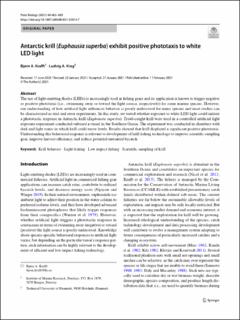| dc.contributor.author | Krafft, Bjørn Arne | |
| dc.contributor.author | Krag, Ludvig Ahm | |
| dc.date.accessioned | 2022-02-09T13:23:43Z | |
| dc.date.available | 2022-02-09T13:23:43Z | |
| dc.date.created | 2022-02-07T16:38:19Z | |
| dc.date.issued | 2021 | |
| dc.identifier.citation | Polar Biology. 2021, 44 (3), 483-489. | en_US |
| dc.identifier.issn | 0722-4060 | |
| dc.identifier.uri | https://hdl.handle.net/11250/2978036 | |
| dc.description.abstract | The use of light-emitting diodes (LEDs) is increasingly used in fishing gears and its application is known to trigger negative or positive phototaxis (i.e., swimming away or toward the light source, respectively) for some marine species. However, our understanding of how artificial light influences behavior is poorly understood for many species and most studies can be characterized as trial and error experiments. In this study, we tested whether exposure to white LED light could initiate a phototactic response in Antarctic krill (Euphausia superba). Trawl-caught krill were used in a controlled artificial light exposure experiment conducted onboard a vessel in the Southern Ocean. The experiment was conducted in chambers with dark and light zones in which krill could move freely. Results showed that krill displayed a significant positive phototaxis. Understanding this behavioral response is relevant to development of krill fishing technology to improve scientific sampling gear, improve harvest efficiency, and reduce potential unwanted bycatch. | en_US |
| dc.language.iso | eng | en_US |
| dc.title | Antarctic krill (Euphausia superba) exhibit positive phototaxis to white LED light | en_US |
| dc.type | Peer reviewed | en_US |
| dc.type | Journal article | en_US |
| dc.description.version | publishedVersion | en_US |
| dc.source.pagenumber | 483-489 | en_US |
| dc.source.volume | 44 | en_US |
| dc.source.journal | Polar Biology | en_US |
| dc.source.issue | 3 | en_US |
| dc.identifier.doi | 10.1007/s00300-021-02814-7 | |
| dc.identifier.cristin | 1998716 | |
| cristin.ispublished | true | |
| cristin.fulltext | original | |
| cristin.qualitycode | 1 | |
